Glyptodon
| Glyptodon Temporal range: Pleistocene | |
|---|---|
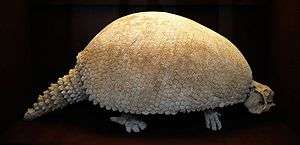 | |
| Fossil specimen at the Naturhistorisches Museum, Vienna | |
| Scientific classification | |
| Kingdom: | Animalia |
| Phylum: | Chordata |
| Class: | Mammalia |
| Superorder: | Xenarthra |
| Order: | Cingulata |
| Family: | Chlamyphoridae |
| Subfamily: | †Glyptodontinae |
| Genus: | †Glyptodon Owen, 1839 |
| Species | |
| |
Glyptodon (from the Greek for "grooved or carved tooth" - Greek γλυπτός sculptured + ὀδοντ-, ὀδούς tooth[1]) was a genus of large, armored mammal of the subfamily Glyptodontinae (glyptodonts or glyptodontines) - relatives of armadillos - that lived during the Pleistocene epoch. It was roughly the same size and weight as a Volkswagen Beetle, though flatter in shape. With its rounded, bony shell and squat limbs, it superficially resembled a turtle, and the much earlier dinosaurian ankylosaur - providing an example of the convergent evolution of unrelated lineages into similar forms.[2][3] In 2016 an analysis of Doedicurus mtDNA found it was, in fact, nested within the modern armadillos as the sister group of a clade consisting of Chlamyphorinae and Tolypeutinae.[4][5] For this reason, glyptodonts and all armadillos but Dasypus were relocated to a new family, Chlamyphoridae.
Discovery
Although Darwin is said to have found the first fossils of glyptodontines (the subfamily), the first mention of the genus Glyptodon in Europe was in 1823, from the first edition of Cuvier's "Ossemens Fossiles."[6] The then unnamed Glyptodon was briefly mentioned in a letter from Don Damsio Laranaga. He had found "a femur... It was about seven pounds, and maybe six or eight inches wide", as well as part of a tail.[6] At the time, the discovery was believed to have belonged to Megatherium, a type of giant ground sloth. A man named Sellow found some carapace plates in three-foot deep clay in Uruguay four years later. That discovery only made the professors even more certain that the discoveries were of the Megatherium, since the bones of this prehistoric giant sloth were usually found in similar conditions and Cuvier had said that the genus was loricated.[6]
Although some believed that the armor resembled that of the modern armadillo, the popular opinion was the Megatherium theory. It was not until Professor E. D’Alton wrote a memoir to the Berlin Academy in 1833 comparing the extreme similarities of these mysterious fossils to that of the armadillo, that the scientific world seriously considered that the pieces of carapaces and fragments of bone could belong to some prehistoric version of Dasypus. D’Alton said that “all the peculiarities of the former [Dasypus] may be paralleled to the latter [fossil pieces]”[6] He concluded that the fossils belonged to some prehistoric version of an armadillo. However, since a full skeleton was not available at the time, he said that his idea was not conclusive. This uncertainty in the fossil remains continued until a man named Dr. Lund identified the remains as a new genus in his 1837 memoir.[6]
Naming of Glyptodon
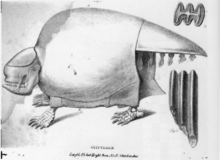
When scholars first acknowledged the genus Glyptodon, there was not a consensus on its name. In 1837 Dr. Lund, a professor who wrote a memoir on Brazil’s ancient fauna, suggested these creatures be recognized as the new genus “Hoplophorus”. In 1838, another scientist, Professor Bronn, published in the second edition of his book Lethaea Geognostica a proposal for the new genus to be called “Chlamydotherium”. In Professor D’Alton’s 1839 memoir, it was called “Pachypus”. The director at the Museum of Natural History in Dijon at the time, M.L. Nodot, had named the genus “Schistopleuron”.[7]
It was finally given a single name when English scholar Richard Owen noticed the similarities of the genera his colleagues were describing in their publications. Owen realized they were all the same genus from their depictions, from carapace to tooth structure. He decided on “Glyptodon”, which means "grooved or carved tooth". The name was originally coined by Sir Woodbine Parish, the man who had sent some Glyptodon fossils to Europe. Those fragments of carapace and bones he sent had been heavily studied at the time and had assisted in the recognition of the new genus.[7]
After unifying the name of this genus, Owen continued working on its taxonomy. In 1845, after analyzing the fossils of his colleagues, he named four species within the genus: G. clavipes, G. reticulatus, G. ornatus, and G. tuberculatus.[7]
Evolution
Glyptodon is part of the superorder of placental mammals known as Xenarthra. This clade of mammals also includes anteaters, tree sloths, armadillos, and extinct ground sloths and pampatheres.
Geography and habitat
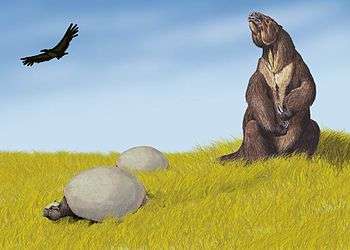
Glyptodon originated in South America. Their remains have been found in Brazil, Uruguay and Argentina. Of the Glyptodon species attributed to remains discovered in Brazil, G. clavipes had the largest range. Its distribution includes north, northeast, and southeast Brazil. G. reticulatus remains have only been found in southern Brazil.[6]
Due to poor morphological and taxonomic understanding, many of the species of the genus and their ranges have not been identified. Countries such as Bolivia, Paraguay and western Uruguay have been recently discovered to have accommodated Glyptodontidae. Material previously assigned to Glyptodon in northeast Brazil has been reassigned to Glyptotherium, restricting the distribution of Glyptodon to the southern region of Brazil. However, two osteoderms with characteristics similar to those of Glyptodon have been recently found in Sergipe state in the northeast, suggesting that both genera occurred in this region during the Pleistocene.[6]
The environments range from forested areas, sub-forested, to warm and humid, while some have become accustomed to open, cold areas where grasslands are the most common. The occurrence of the genus has also been observed in the southwestern part of the Amazon basin, which suggests that the wide diversity of the genus was due to the diverse climates within its range.[8]
During the Great American Interchange, a set of migrations that occurred after North and South America were connected by the rising of the volcanic Isthmus of Panama, Glyptodon migrated into Central America as far as Guatemala.[9] A closely related genus, Glyptotherium, reached the southern region of the modern U.S. about 2.5 million years ago.[10]
Feeding habits

Two main groups of glyptodonts can be distinguished by their feeding habits. Smaller-sized early Miocene propalaehoplophorids had narrow muzzles,[11] while larger post-Miocene glyptodonts developed wider muzzles. The smaller glyptodonts were selective feeders, while the larger glyptodonts were bulk feeders. However, because of their body form and fusion of the cervical vertebrae, all members of Glyptodon would have needed to forage near the ground. Their craniomandibular joint limited their jaw to side-to-side movement.[12]
The feeding habits of Glyptodon, based on their jaw morphology, were herbivorous. Glyptodon had an “elaboration of the osteodentine ridges in their jaw that provided an effective grinding mill, causing the food particles to be pushed and sheared through constant motion of the mandible, allowing Glyptodon to consume their dietary needs.” They had a well-developed snout musculature, along with a mobile neck region that helped them secure food.[13]
Like most other xenarthrans, glyptodonts had lower energy requirements than most other mammals. They could survive with lower intake rates than other herbivores with similar mass.[14]
Glyptodon grazed near water sources such as rivers and lakes. Based on stable isotope analysis, it is evident that its diet consisted primarily of dicotyledonous trees and monocotyledonous grasses.[15]
Behavior
Glyptodonts are believed to have taken part in intraspecific fighting. Zoologists presume that since the tail of Glyptodon was very flexible and had rings of bony plates, it was used as a weapon in fights. This indicates that glyptodonts fought among themselves. They settled disputes by fighting each other, much like male-to-male fighting among deer using their antlers. Although its tail could be used for defense against predators, evidence suggests that the tail of Glyptodon was primarily for attacks on its own kind. A G. reticulatus fossil displays damage done on the surface of its carapace. Using physics and mathematics, a group of zoologists calculated the amount of force required to break the carapace of Glyptodon. The calculation showed that Glyptodon tails would be able to break the carapace, thus hinting that it practiced intraspecific fighting.[16]
Anatomy
.jpg)
Glyptodon measured 3.3 m (10.8 ft) in length, 1.5 m (4.9 ft) in height and weighed up to 2 tonnes.[17]
Skull
The nasal passage was reduced with heavy muscle attachments for some unknown purpose. Some have speculated that the muscle attachments were for a proboscis, or trunk, much like that of a tapir or elephant. The lower jaws were very deep and helped support massive chewing muscles to help chew coarse fibrous plants. Teeth resembled those of an armadillo, but were fluted on each side by deep grooves. The anterior teeth were compressed, while the posterior teeth were cylindrical.[18] A distinctive bar of bone projects downwards on the cheek, extending over the lower jaw, perhaps providing an anchor for powerful snout muscles. Another suggestion, made by A.E. Zurita and colleagues, is that the large nasal sinuses could be correlated with the cold arid climate of Pleistocene South America.[19][20]
Osteoderms
Before the Pleistocene, Glyptodon’s osteoderms were attached by syntoses and were found in double or triple rows on the front and sides of the carapace’s edges, as well as in the tail armor and cephalic shield. The carapace’s osteoderms were conical with a rounded point, while the ones on the tail were just conical. The sulci between these raised structures were deep and wide with parallel lines.[21]
In the early 2000s, the presence of osteoderms on Glyptodon’s face, hind legs, and underside was confirmed in several species. The fossils with these characteristics were from the Pleistocene. These small to medium-sized ossicles were actually embedded in the dermis and did not connect in a pattern.[21]
The appearance of this new trait coincides with the arrival of North American predators in South America as part of the Great American Interchange, after the two continents became connected about three million years ago. For this reason, some scientists hypothesize that the osteoderms developed as a defensive/offensive mechanism. This belief is furthered by the discovery of fractured dorsal armor, which implies that Glyptodon had been in physical conflict with other species.[21]
Carapace
It was covered by a protective shell composed of more than 1,000 2.5 cm-thick bony plates, called osteoderms or scutes. Each species of glyptodont had its own unique osteoderm pattern and shell type. With this protection, they were armored like turtles. Unlike most turtles, glyptodonts could not withdraw their heads, but instead had a bony cap on the top of their skull. Even the tail of Glyptodon had a ring of bones for protection. Such a massive shell needed considerable support, evidenced by features such as fused vertebrae, short but massive limbs, and a broad shoulder girdle.[22]
Tail
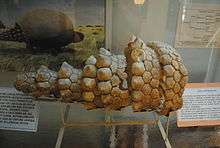
Certain differences in tail morphology appear from species to species. Some species, like Glyptodon clavipes, had a tail covered in free bony rings of dermal structures that made for a strong, flexible, and mobile appendix. This enabled the mammal to use the muscles along its tail to powerfully swing it.[23]
The rings in other species' tails were fused together, making the tail a single piece of rigid bone. These rings measured up to 1 mm in diameter. However, the rings closer to the animal's body were not rigid, allowing the mammal to swing its tail, much like a baseball player swings a bat. At the end of the tail some Glyptodon species had spikes made out of keratin.
The accessory ring, or caudal ring 1 has a short double row of small scutes. The proximal row has several small pentagonal scutes; the distal row includes more large pentagonal scutes than the caudal row. The scutes on the proximal row have convex shape, and each scute supports a pair of hair follicles. Ring 2 is the first complete caudal ring and it is the largest ring. It is consisted by two complete rows of firmly sutured scutes. The distal/ending scutes are larger, and their free margins are rounded producing a fanlike shape. Ring 3, the second complete ring, is almost the same as ring 2 except the smaller size and some of the scutes at the ending row reach the proximal margin, crowding the proximal scutes and making the proximal row incomplete despite the same number of 20 scutes in both rows. Rings 4-10 have decreasing diameters and increasing maximum length at the back (from 4 to 10). The rings have double rows, and have decreasing number of scutes in each row from ring 4 to ring 10.[13]
Glyptodon may have used their tails in competition for resources and also as an ornament when competing for sexual partners.
Spine
Glyptodon had thirteen consecutive vertebrae. Four of the thirteen anterior vertebrae are so close together that they are barely discernible. The other vertebrae are connected by sutures, which become farther apart the closer they are to the posterior. Each centrum is a thin bony plate that curves in such a way that that forms a hollow cylinder. The cylinder in the vertebrae is much larger in diameter near the front rather than the hinder vertebrae, The foremost vertebra is as wide as the posterior part of the trivertebral bone. Then the vertebrae narrows rapidly until it reaches the fourth vertebra which is no more than three-fifths as wide as the first one.
Eyesight
Rod monochromacy is a rare condition characterized by the absence of cone photoreceptor cells in the eyes of vertebrates. It results in colorblindness and low acuity vision in dim-light conditions and blindness in bright-light conditions. Xenarthrans most likely only used vision at night, during twilight, and while in burrows. However, the understory of South America's rainforests may have been dark enough during the day to facilitate limited vision for species that dwelled there. Extinct glyptodonts' tough carapace and large body size might have compensated for their inability to see approaching predators.[25]
Predation

The evidence for predation on glyptodonts is very scarce, limited to a Pliocene skull (Glyptotherium) in North America and some latest Pleistocene-early Holocene specimens in South America, with signs of human consumption.[26]
Extinction
Some evidence suggests that humans drove glyptodonts to extinction.[27] Hunters may have used the shells of dead animals as shelters in inclement weather.[28][29] Evidence from the Campo Laborde and La Moderna archaeological sites in the Argentine Pampas suggests that Glyptodon's relative Doedicurus and another glyptodont survived until the Early Holocene, coexisting with humans for a minimum of 4,000 years.[30] This overlap provides support for models showing the South American Pleistocene extinctions resulted from a combination of climatic change and anthropogenic causes.[30] These sites have been interpreted as ones used for butchering of megafauna (Megatherium and Doedicurus); however, some of the chronology has been problematic and controversial, due to poor preservation of the collagen used for dating.[30]
See also
-
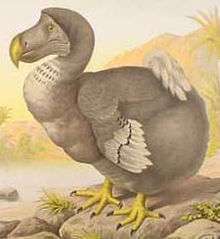 Extinction portal
Extinction portal -
 Paleontology portal
Paleontology portal -
 Prehistoric mammals portal
Prehistoric mammals portal
References
- ↑ "glyptodon". Oxford English Dictionary (1st ed.). Oxford University Press. 1933.
- ↑ Fariña, Richard A.; Vizcaíno, Sergio F.; De Iuliis, Gerry (22 May 2013). Megafauna: Giant Beasts of Pleistocene South America. Indiana University Press. ISBN 0-253-00719-4. OCLC 779244424.
- ↑ Arbour, V. M.; Currie, P. J. (2015-08-31). "Ankylosaurid dinosaur tail clubs evolved through stepwise acquisition of key features". Journal of Anatomy. 227 (4): 514–523. doi:10.1111/joa.12363. PMID 26332595.
- ↑ Delsuc, F.; Gibb, G.C.; Kuch, M.; Billet, G.; Hautier, L.; Southon, J.; Rouillard, J.-M.; Fernicola, J. C.; Vizcaíno, S. F.; MacPhee, R. D.E.; Poinar, H. N. (2016-02-22). "The phylogenetic affinities of the extinct glyptodonts". Current Biology. 26 (4): R155–R156. doi:10.1016/j.cub.2016.01.039.
- ↑ Gillian C. Gibb; Fabien L. Condamine; Melanie Kuch; Jacob Enk; Nadia Moraes-Barros; Mariella Superina; Hendrik N. Poinar; Frédéric Delsuc (2016). "Shotgun Mitogenomics Provides a Reference Phylogenetic Framework and Timescale for Living Xenarthrans". Molecular Biology and Evolution. doi:10.1093/molbev/msv250.
- 1 2 3 4 5 6 7 Dantas, M. A. T.; França, L. M.; Cozzuol, M. A.; Rincón, A. D. (2013). "About the occurrence of Glyptodon sp. in the Brazilian intertropical region". Quaternary International. 305: 206–208. doi:10.1016/j.quaint.2011.06.024.
- 1 2 3 Huxley, Thomas H. (1865). On the Osteology of the Genus Glyptodon. Philosophical Transactions of the Royal Society of London 1865: The Royal Society Publishing. pp. 31–70.
- ↑ Zurita, A. E.; Miño-Boilini, Á. R.; Soibelzon, E.; Carlini, A. A.; Ríos, F. P. (2009). "The diversity of Glyptodontidae (Xenarthra, Cingulata) in the Tarija Valley (Bolivia): systematic, biostratigraphic and paleobiogeographic aspects of a particular assemblage". Neues Jahrbuch für Geologie und Paläontologie - Abhandlungen. 251 (2): 225–237. doi:10.1127/0077-7749/2009/0251-0225. ISSN 0077-7749.
- ↑ "Glyptodon Owen 1839". Paleobiology Database. Retrieved 2014-09-09.
- ↑ Morgan, G. S. (2008). "Vertebrate Fauna and Geochronology of the Great American Interchange in North America". In Lucas, S. G.; Morgan, G. S.; Spielmann, J. A; et al. Neogene Mammals: Bulletin 44. New Mexico Museum of Natural History and Science. pp. 93–140 (see pp. 115–116). GGKEY:UP5Z0XQUK5R.
- ↑ "Bargo M. S. Vizcaíno S. F. — Paleobiology of Pleistocene ground sloths (Xenarthra, Tardigrada) : biomechanics, morphogeometry and ecomorphology applied to the masticatory apparatus. Ameghiniana". ResearchGate. Retrieved 2015-10-30.
- ↑ Fariña, R.A. (2001). "Carved Teeth and Strange Jaws: How Glyptodonts Masticated." (PDF). Acta Palaeontologica Polonica.
- 1 2 Gillette, R. (21 December 1981). "Glyptodonts of North America" (PDF). Smithsonian Publications. Retrieved 2015-10-29.
- ↑ "Evaluating Habitats and Feeding Habits Through Ecomorphological Features in Glyptodonts (Mammalia, Xenarthra)". ResearchGate. doi:10.5710/AMGH.v48i3(364). Retrieved 2015-10-29.
- ↑ Adrian Perez-Crespo, Victor (Jan 2012). "Diet and habitat definitions for Mexican glyptodonts from Cedral (San Luis Potosí, México) based on stable isotope analysis". Geological Magazine. 149: 153–157. doi:10.1017/S0016756811000951.
- ↑ Alexander, R. M.; Fariña, R. A.; Vizcaíno, S. F. (May 1999). "Tail blow energy and carapace fractures in a large glyptodont (Mammalia, Xenarthra)". Zoological Journal of the Linnean Society. 126 (1): 41–49. doi:10.1111/j.1096-3642.1999.tb00606.x.
- ↑ http://angellis.net/Web/PDfiles/edents.pdf
- ↑ Flower, W.H. (1871). "Professor Flower's Hunterian Lectures On The Teeth and Allied Organs In The Mammalia". The British Medical Journal.
- ↑ Fernicola, Juan Carlos; Néstor Toledo; M. Susana Bargo,; Sergio F. Vizcaíno (October 2012). "A neomorphic ossification of the nasal cartilages and the structure of paranasal sinus system of the glyptodont Neosclerocalyptus Paula Couto 1957 (Mammalia, Xenarthra)". Palaeontologica Electronica: Article 15.3.27A.
- ↑ Gillette, David D. (2010). "Glyptodonts in arizona a saga of supercontinents, sea-floor spreading, savannas, and sabertooth cats". Arizona Geological Survey. Retrieved 25 March 2014.
- 1 2 3 Zurita, A. E.; Soibelzon, L. H.; Soibelzon, E.; Gasparini, G. M.; Cenizo, M. M.; Arzani, H. (2010). "Accessory protection structures in Glyptodon Owen (Xenarthra, Cingulata, Glyptodontidae)". Annales de Paléontologie. 96 (1): 1–11. doi:10.1016/j.annpal.2010.01.001.
- ↑ David Lambert and the Diagram Group. The Field Guide to Prehistoric Life. New York: Facts on File Publications, 1985. pp. 196. ISBN 0-8160-1125-7
- ↑ Blanco, R. E.; Jones, W. W.; Rinderknecht, A. (2009-11-22). "The sweet spot of a biological hammer: the centre of percussion of glyptodont (Mammalia: Xenarthra) tail clubs". Proceedings of the Royal Society B: Biological Sciences. 276 (1675): 3971–3978. doi:10.1098/rspb.2009.1144. JSTOR 30245090.
- ↑ Huxley, Thomas Henry (1862-01-01). "Description of a New Specimen of Glyptodon, Recently Acquired by the Royal College of Surgeons of England". Proceedings of the Royal Society of London. 12: 316–326. doi:10.1098/rspl.1862.0071. JSTOR 112260.
- ↑ Emerling, Christopher A.; Springer, Mark S. (2015-02-07). "Genomic evidence for rod monochromacy in sloths and armadillos suggests early subterranean history for Xenarthra". Proceedings of the Royal Society of London B: Biological Sciences. 282 (1800): 20142192. doi:10.1098/rspb.2014.2192. ISSN 0962-8452. PMC 4298209
 . PMID 25540280.
. PMID 25540280. - ↑ de los Reyes, M.; Poiré, D. G.; Soibelzon, L.; Zurita, A. E.; Arrouy, M. J. (May 2013). "First evidence of scavenging of a Glyptodont (Mammalia, Glyptodontidae) from the Pliocene of the Pampean region (Argentina): taphonomic and paleoecological remarks" (PDF). Paleontologia Electronica. 16 (2). Retrieved 2015-11-06.
- ↑ Martin, P. S.; Steadman, D. W. (1999-06-30). "Prehistoric extinctions on islands and continents". In MacPhee, R. D. E. Extinctions in near time: causes, contexts and consequences. Advances in Vertebrate Paleobiology. 2. New York: Kluwer/Plenum. pp. 17–56; see p. 38. ISBN 978-0-306-46092-0. OCLC 41368299. Retrieved 2015-11-07.
- ↑ Fidalgo, F., et al. (1986) "Investigaciones arqueológicas en el sitio 2 de Arroyo Seco (Pdo. de Tres Arroyos, prov. de Buenos Aires, República Argentina)" In: Bryan, Alan (ed.) (1986) New evidence for the Pleistocene peopling of the Americas Peopling of the Americas Symposia Series, Center for the Study of Early Man, University of Maine, Orono, Maine, ISBN 0-912933-03-8, pp. 221-269, in Spanish
- ↑ Politis, Gustavo G. and Gutierrez, Maria A. (1998) "Gliptodontes y Cazadores-Recolectores de la Region Pampeana (Argentina)" ("Glyptodonts and Hunter-Gatherers in the Pampas Region (Argentina)") Latin American Antiquity 9(2): pp.111-134 in Spanish
- 1 2 3 Politis, G. G.; Messineo, P. G. (November 2008). "The Campo Laborde site: New evidence for the Holocene survival of Pleistocene megafauna in the Argentine Pampas". Quaternary International. 191 (1): 98–114. doi:10.1016/j.quaint.2007.12.003.
External links
-
 Media related to Glyptodon at Wikimedia Commons
Media related to Glyptodon at Wikimedia Commons